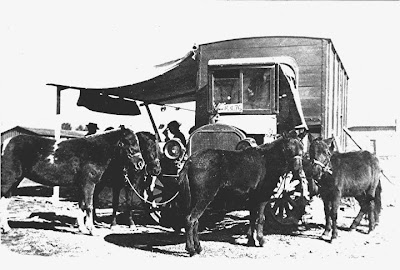Sepia Saturday: Feeding the Harvesters
In the days of yore, back when the wheat was harvested manually by dozens of men all working a field until it was nothing but stubble before they moved on to the next farm, the workers would get powerfully hungry. They were, after all, expending a lot of energy harvesting grain and possibly fruit, as well.
Back in the 1890s and probably for a couple of decades after that, the Walla Walla Valley harvest crews were fed meals from cook wagons like this one. These wagons were mobile kitchens -- kind of like the taco wagons you see in some parking lots at lunch time. I suspect the one in the picture was a later model, because it's a "horseless" wagon.
But it was staffed by women, sometimes farmer's wives and sometimes widows or single women needing some income. They spent their days cooking hearty fare to feed the hungry men bringing in the crops.
My great-grandmother Wilhelmina "Minnie" Blomgren Nelson was one of those widows. Her first husband John Albert Nelson died of tuberculosis quite young, leaving her to support her two small surviving children. She was able to continue living on their farm and even managed to perfect the homestead claim after he died. But money was always an issue.
So Minnie used her skills as a cook during harvest time to help make ends meet. I imagine there were hearty stews, strong coffee, and Apple Brown Betty or tasty pies for lunch and dinners. She'd only been in the U.S. a few years at that point, so it must have been a challenge to adapt to cooking American dishes and conversing with other cooks in English instead of her native Swedish.
My great-grandfather Samuel was one of the hired men who helped harvest crops each season. He was in the process of proving up his own homestead claim in Eastern Oregon, but there was work in the Walla Walla Valley, so he'd ride his horse or bring a buggy down from the Blue Mountains of eastern Oregon into the fertile valley in Washington to earn money to supplement his income.
Samuel, like Minnie, was a down-to-earth and practical Swede. No one ever told stories about their meeting or their courtship when I was a little girl. Samuel was long since dead. In fact, Samuel died before my mother was born. And Minnie was too matter-of-fact to dwell on her youth.
So I imagine that he caught a glimpse of her serving food when he approached to cook wagon for his midday meal. I imagine he was taken by her small size, her rosy cheeks, and basic sweetness. I have no doubt that when he heard a hint of Swedish accent, he knew that this young widow was meant to be his bride. Did he brashly approach her? Or did he hang back, slowly letting her notice him? Did they speak their first words of love in Swedish? My mother and her sisters never heard their grandmother speak Swedish. She only spoke English, at least her version of it, because, she said, "I'm an American now."
They had about 25 years together before Samuel, who was several years older than Minnie, dropped dead from a heart attack as he walked his land with his step-son and eldest son. Minnie never married again. She lived to her mid-90s.




Comments
Your stories are always informative and capture my interest...and you tell them so well...
Your Great Grandma must have been a strong adaptable woman, she needed to be didn't she...
Happy days
But the seed of the story is potent enough for you to tell it to us so intriguingly.
Kim
My husbands Great Grandfather and Great Grandmother were John and Minnie too :) Not Nelson though. We have delighted in our ancestry search so far. I hope soon we will have stories such as yours to share!
Great history lesson as well.